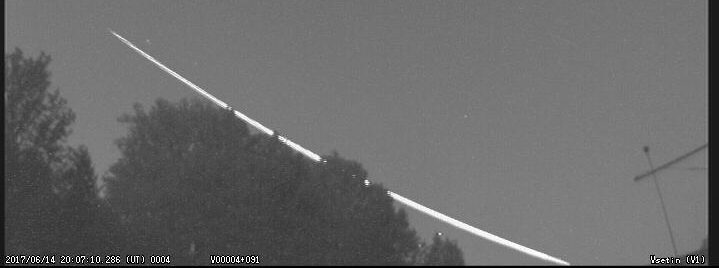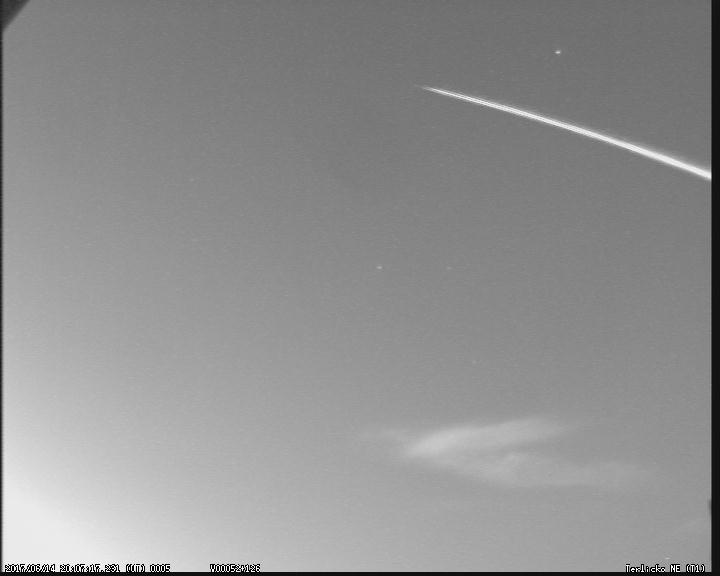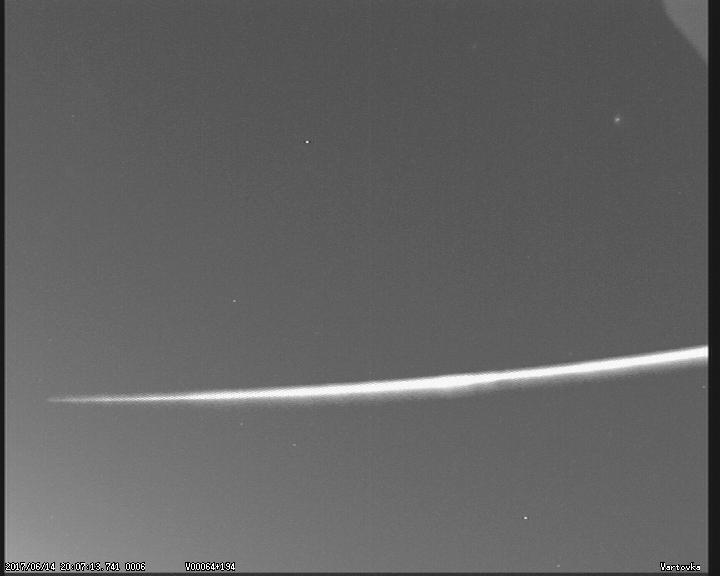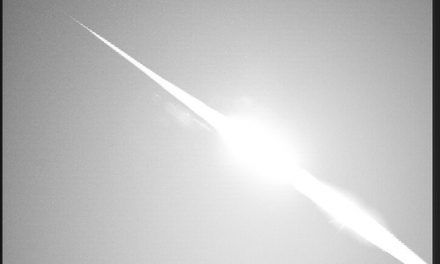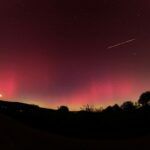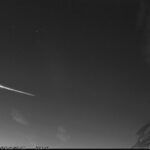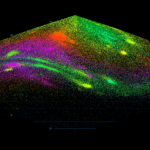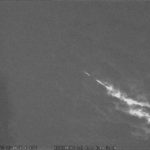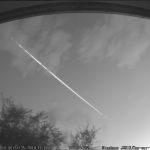Jakub Koukal¹
¹ Valašské Meziříčí Observatory, Vsetínská 78, 75701 Valašské Meziříčí, Czech Republic
j.koukal@post.cz
Abstract
During twilight on June 14, 2017, CEMeNt network cameras recorded a long and bright fireball with an absolute magnitude of -7.9 ± 0.2m, whose atmospheric path began over the northwest of the Romania and ended up above southern Poland. This fireball belonging to the Southern sigma Sagittariids meteor shower was recorded from 9 cameras of the CEMeNt network. Atmospheric path of the fireball as well as heliocentric orbit of the meteoroid are analyzed within the article.
Introduction
During twilight on June 14, 2017, a bright fireball with an absolute magnitude of -7.9 ± 0.2m flew over four European countries (Romania, Hungary, Slovakia and Poland). The fireball was visually observed from several locations in the Czech Republic (Nýdek, Brno, Uherský Brod), most of the observations reported relative brightness between -6 and -12m. At the time of the event, above the territory of the Czech Republic, Poland and Slovakia the sky was cloudless, which was also reflected in the number of records from the CEMeNt network stations or in the number of visual observations. The flight of this fireball, which belongs to the Southern sigma Sagittariids meteor shower, was confirmed by CEMeNt network cameras, which recorded it at 20h07m07.2 ± 0.1s UT. The fireball was included in the EDMOND database (Kornoš et al. 2014a) with the designation 20170614_200707, which accurately identifies the observation time in the YYYYMMDD_HHMMSS format.
The Southern sigma Sagittariids meteor shower (168 SSS) is one of the weaker and less known showers. In the IAU MDC meteor showers database (Jopek et al. 2014), there is only one mean orbit of this shower (Sekanina 1976) that was taken from radar observations. This meteor shower is very little explored, the mean orbit of the shower comes from radar observations from 1968 and 1969. The orbital elements of shower mean orbit are as follows: vg = 29.3 km/s, a = 2.594 AU, q = 0.361 AU, e = 0.861, i = 2.8°, ω = 113.6°, Ω = 267.4°, coordinates of geocentric radiant (J2000.0) are RA = 278.6°, DEC = -25.3°. The mean orbit was calculated from the 29 individual orbits belonging to the shower. The asteroid 2001 MEW1 is assumed to be the parent body, but the relationship of the Scutid meteor shower and this asteroid has not yet been established.
Instrumentation and methodology
Wide field systems. Video systems used in the CEMeNt network (Figure 1) are generally based on various types of sensitive CCTV cameras with CCD sensors (Sony Ex-View HAD, Sony Super HAD II, Sony Super HAD 960 H Effio) of size 1/3″ or 1/2″ with fast (~ f / 1.0) varifocal lenses with PAL B image resolution (720 × 576 px). Most of the stations have a field of view within the range of 60° – 90° in the horizontal direction.
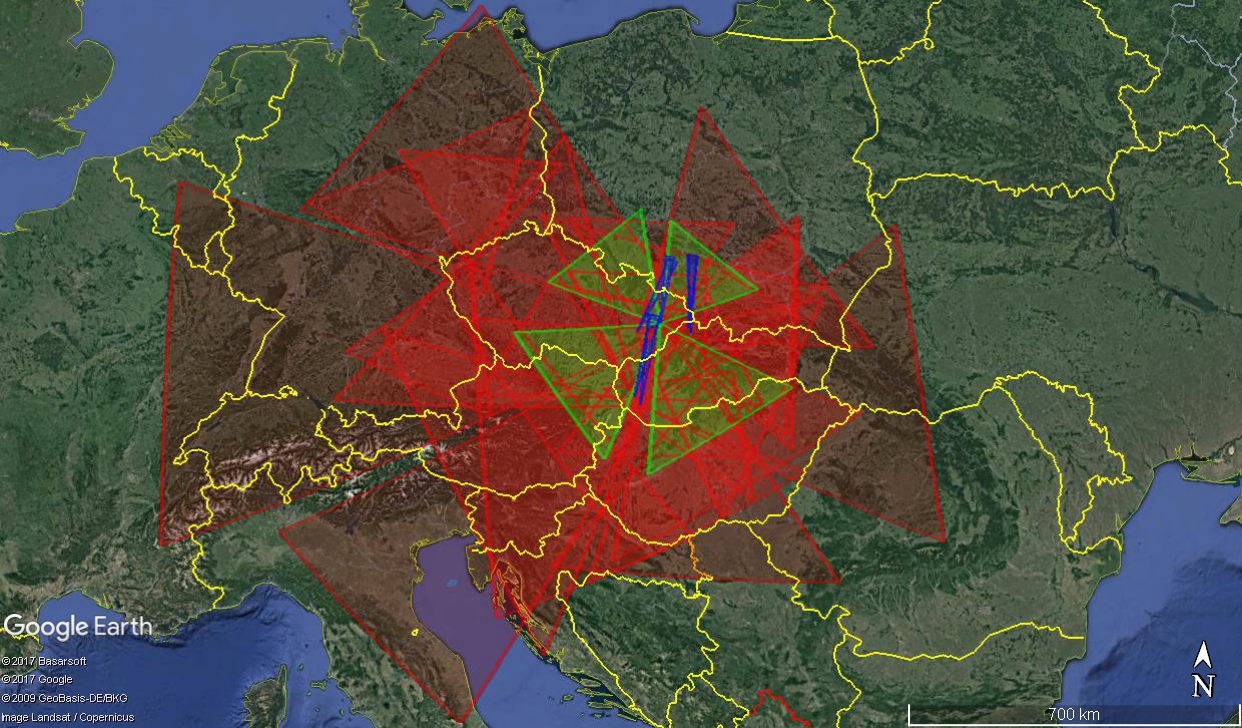
Fig. 1 – 2D projection of videocameras FOV in the CEMeNt network. Wide field systems are marked in red. Author: Jakub Koukal
Detection software, processing. Detection of meteors is done by UFOCaptureV2 software (SonotaCo 2009), and for astrometric and photometric processing UFOAnalyzerV2 software (SonotaCo 2009) is used. Orbits of meteoroids in the solar system are calculated using the software UFOOrbitV2 (SonotaCo 2009). Deceleration is counted out of this software as an exponential fit of the actual speed of the meteor for each frame. The Drummond´s orbit similarity criterion (Drummond 1981) is used to assign a meteor to the meteor shower, the limit value of this criterion is set at DD < 0.1. To estimate the initial meteoroids weight was used empirical equation (Jacchia et al. 1967), based on observations of 413 bright meteors. The equation defines the dependence of the initial meteoroids weight on the photometric absolute magnitude, meteoroids geocentric speed and zenithal angle of the observed meteors radiant.
EDMOND database
At present, there are 4 655 640 individual meteor records (from 2000 to 2016) in the EDMOND database, of which 592 699 multi-station orbits (so-called Q0 orbits or raw orbits) have been created. The database itself is understood to be multiplatform, therefore combines outputs from systems with different parameters as well as from systems with different recording and evaluation methodology (UFO Capture, MetRec, CMN). Because of the inhomogeneity of the input data, it is necessary to establish reduction criteria within the EDMOND database (Kornoš et al. 2014a,b), which makes it possible to exclude orbits from the database that does not meet the required geometric conditions or due to inhomogeneity they are not compatible. The result of applying the reduction criteria is a significant reduction to 326,823 multi-station orbits that are stored in the output version of the EDMOND database. The multi-station orbits are necessary to determine the origin of the body and due to the knowledge of the heliocentric parameters of the meteoroid orbit and the complementary parameters (e.g. the Tisserand´s parameter TJ in relation to the Jupiter) it is possible to determine whether the body is of cometary or asteroid origin or belongs to one of the known meteor showers.
Atmospheric path, radiant and heliocentric orbit of the fireball
To calculate the atmospheric path of the fireball 20170614_200707 and the meteoroids orbit in the Solar System were used records taken from stations Kroměříž ENE (Figure 2), Vsetín E (Figure 5), Těrlicko NE (Figure 6), Blahová E (Figure 8) and Kráčany N (Figure 9). The records taken from stations Kroměříž SE (Figure 3), Maruška SE (Figure 4) and Vartovka NE (Figure 7) were not used for the calculation of the meteoroids orbit.
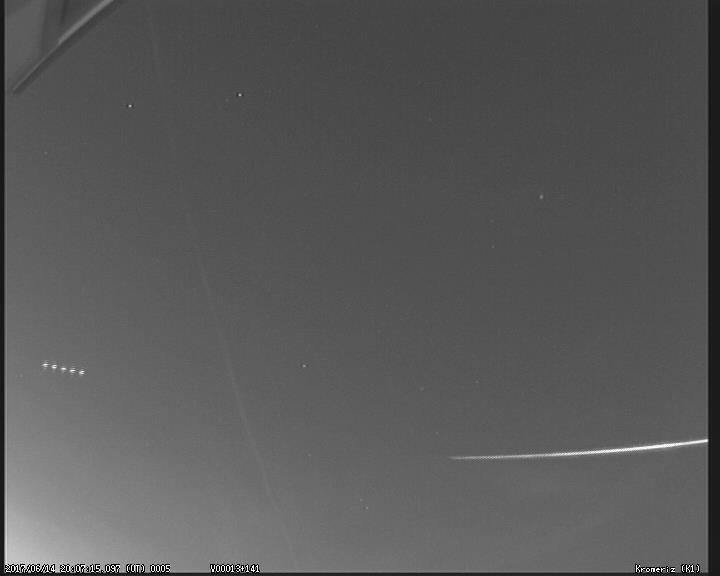 |
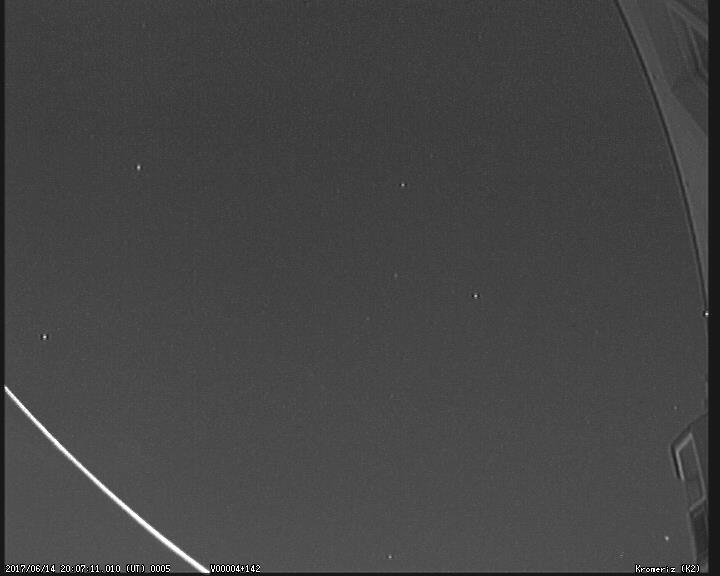 |
| Fig. 2 – Summary image of the fireball 20170614_200707, station Kroměříž ENE. Author: Jakub Koukal | Fig. 3 – Summary image of the fireball 20170614_200707, station Kroměříž SE. Author: Jakub Koukal |
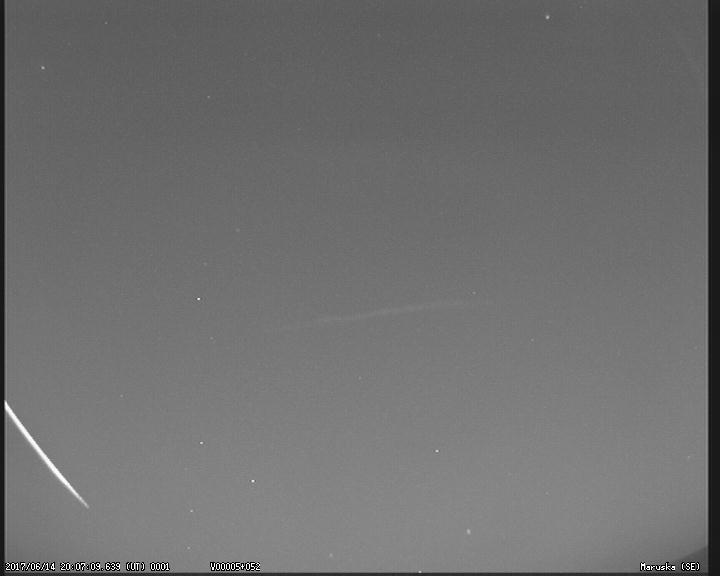 |
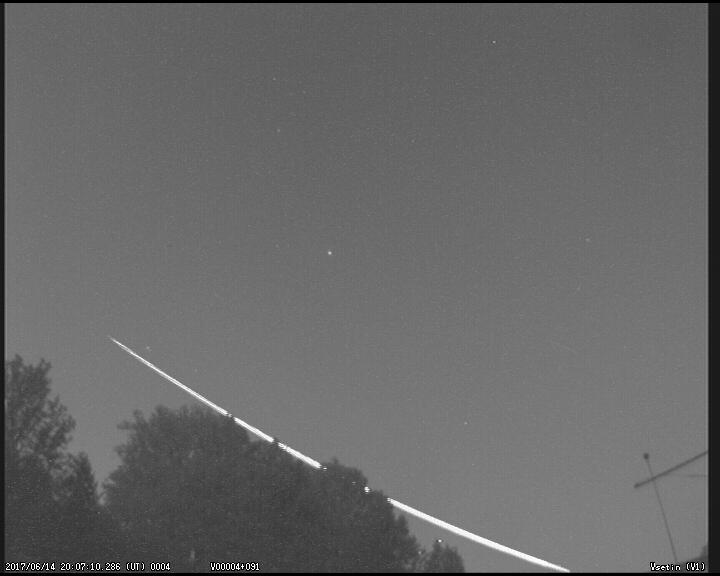 |
| Fig. 4 – Summary image of the fireball 20170614_200707, station Maruška SE. Author: Jakub Koukal | Fig. 5 – Summary image of the fireball 20170614_200707, station Vsetín E. Author: Hvězdárna Vsetín |
 |
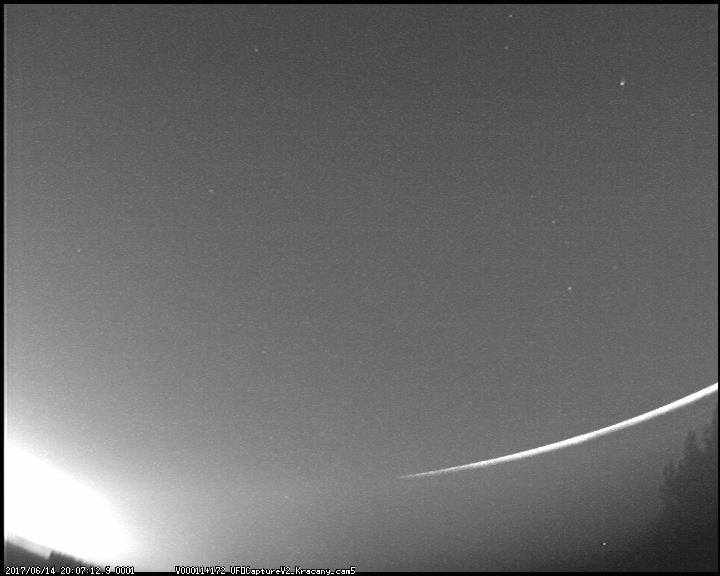 |
| Fig. 8 – Summary image of the fireball 20170614_200707, station Blahová E. Author: UMa Astronomy | Fig. 9 – Summary image of the fireball 20170614_200707, station Kráčany N. Author: UMa Astronomy |
The projection of the beginning of the atmospheric path was located at coordinates N47.519745° E23.235519° near the village of Rodina (Romania), the height of the fireball at this time was 94.4 ± 0.1 kilometers above the Earth’s surface. The end of the projection of the atmospheric path was located at coordinates N50.032967° E19.378588° near the village of Balusie (Poland), the height of the fireball at this time was 85.3 ± 0.1 kilometers above the Earth’s surface (Figure 10). The fireball reached absolute brightness -7.9 ± 0.3m (Figure 11), an estimated initial mass of the body is 3.11 ± 0.49 kg (Jacchia et al. 1967).
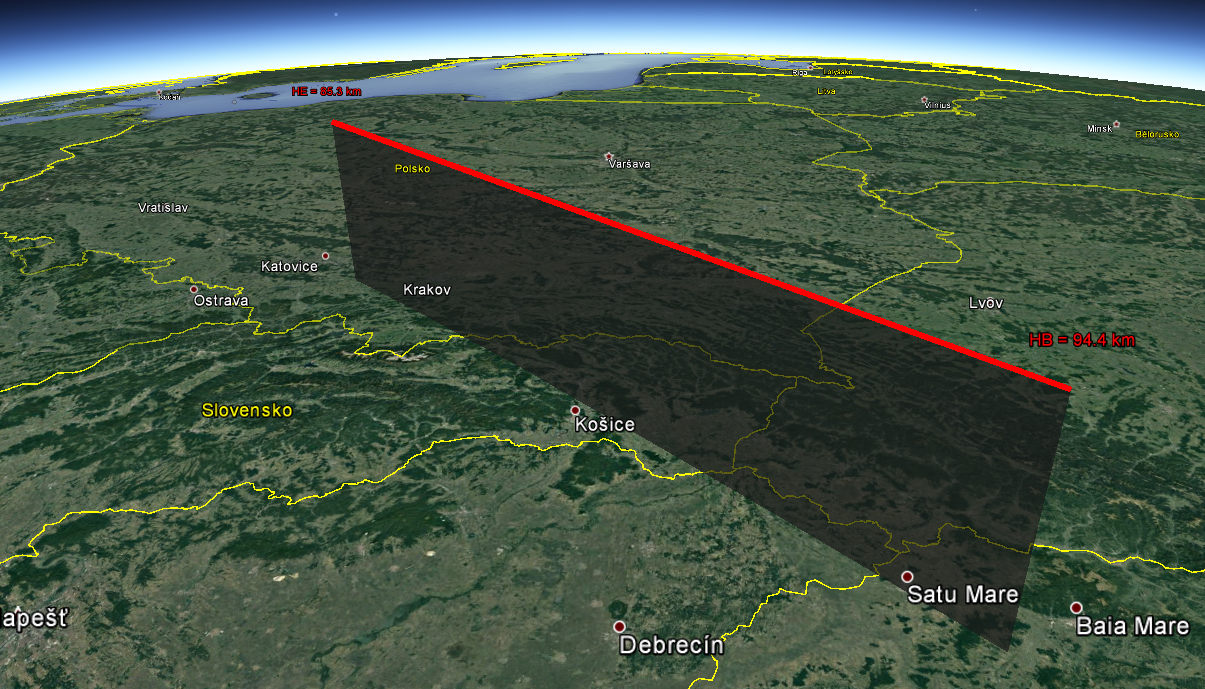
Fig. 10 – 3D projection of the atmospheric path of the fireball 20170614_200707 on the Earth´s surface. Author: Jakub Koukal
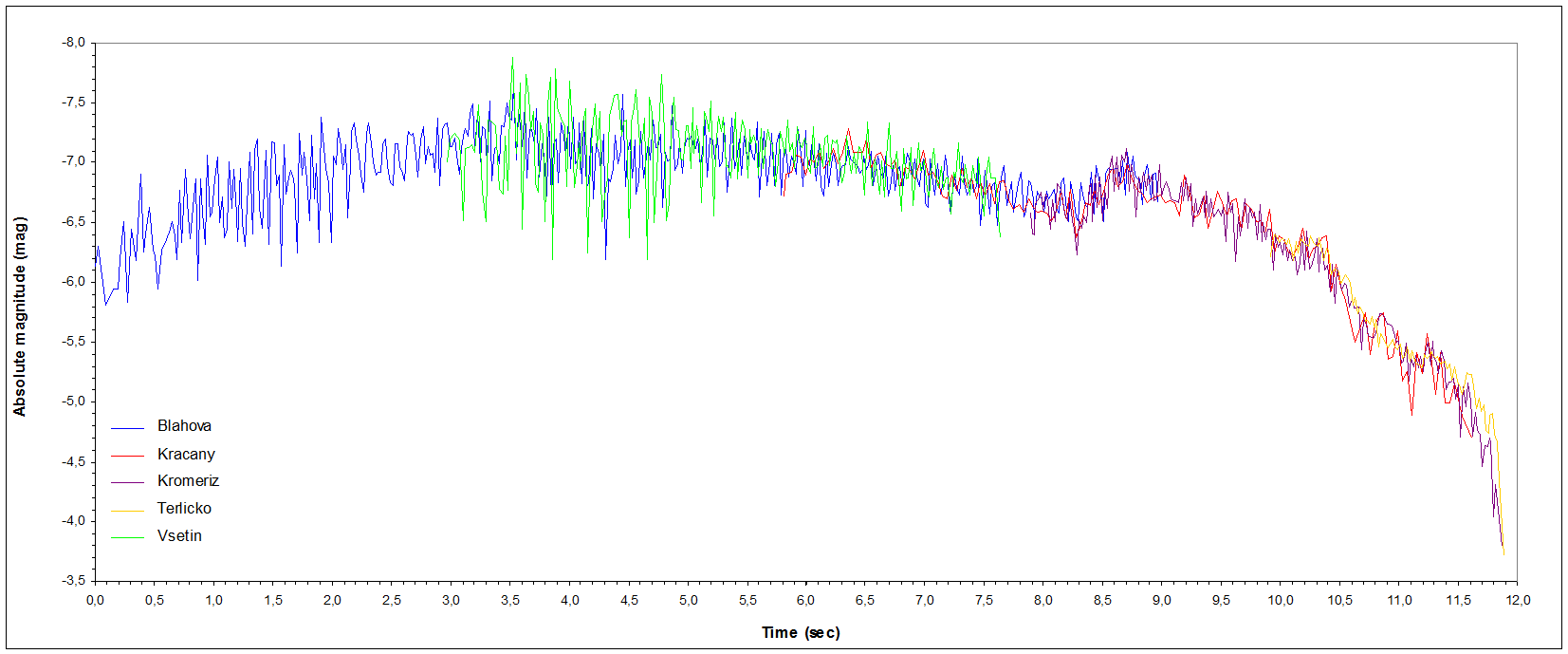
Fig. 11 – The course of the absolute magnitude of the fireball 20170614_200707 from individual stations. Author: Jakub Koukal
It was a relatively slow meteor, its geocentric velocity before entering the Earth’s gravitational field (vg) was 30.89 ± 0.41 km/s (including the effect of the deceleration). Velocity before entering the Earth’s atmosphere (vi) was 33.09 ± 0.39 km/s. The orbital elements of the meteoroid orbit in the Solar System were as follows : a = 2.064 ± 0.130 AU (semi-major axis), q = 0.2831 ± 0.0025 AU (perihelion distance), e = 0.863 ± 0.007 (eccentricity), i = 9.32 ± 0.05° (inclination), ω = 123.86 ± 0.06° (argument of the perihelion), Ω = 263.7059° (longitude of the ascending node). The bolide was a member of the Southern sigma Sagittariids meteor shower (IAU MDC #168 SSS) with the geocentric radiant RA = 280.73 ± 0.09° (right ascension), DEC = -29.49 ± 0.13° (declination). The projection of the meteoroid orbit in the Solar system is shown in Figure 12, including the effect of the deceleration on the geocentric velocity vg. The orbital heliocentric parameters of the meteoroid orbit are shown in Table 1, the geocentric orbit parameters then in Table 2.
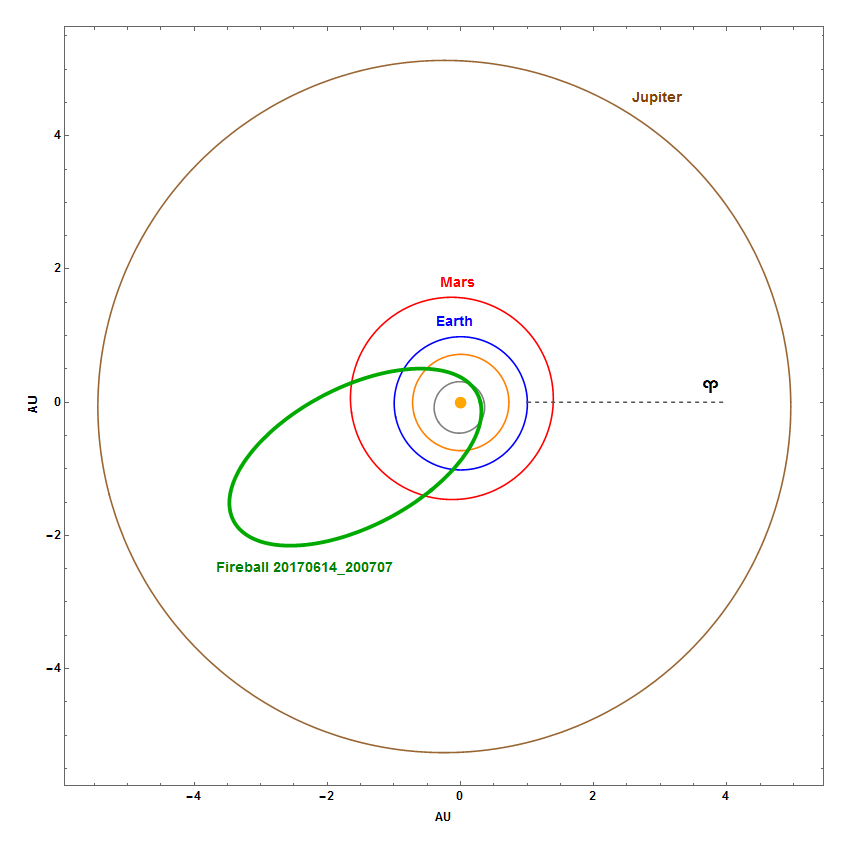
Fig. 12 – Orbit of the bolide 20170614_200707 in the Solar System, the effect of deceleration is considered in the calculation. Author: Jakub Koukal

Table 1 – Heliocentric orbital elements (J2000.0) of the fireball 20170614_200707, calculated using software UFOOrbit (SonotaCo 2009), the effect of deceleration is considered in the calculation. Author: Jakub Koukal

Table 2 – Geocentric radiant, geocentric velocity, beginning and terminal height of the fireball 20170614_200707, calculated using software UFOOrbit (SonotaCo 2009), the effect of deceleration is considered in the calculation. Author: Jakub Koukal
Conclusions
The length of the fireball 201710614_200707 path in the Earth’s atmosphere was 403.6 km, it is one of the longest meteors in the EDMOND database. It was not an Earth-grazer, the body disappeared in the atmosphere of the Earth. Given the Tisserand´s parameter (TPJ = 3.15 ± 0.11), the asteroid origin of the body (A-C type) can be assumed.
Acknowledgements
Acknowledgment belongs to all station owners, operators and observers for their long-term and precise work, which enabled the establishment and development of the CEMeNt network. Acknowledgment also belongs to all interested institutions in support of activities and network growth. The KOSOAP (Cooperating Network of Astronomic Observational Projects, in Czech: Kooperující síť v oblasti astronomických odborně-pozorovatelských programů) and RPKS (Evolvement of the Cross Border Network for Scientific Work and Education, in Czech: Rozvoj přeshraniční kooperující sítě pro odbornou práci a vzdělávání) projects were realized by the Valašské Meziříčí Observatory (CZ) and Kysucké Nové Město Observatory (SR) in cooperation with the Society for Interplanetary Matter. Projects were co-funded by European Union (Cross-border Cooperation Programme Slovak Republic – Czech Republic 2007-2013).
References
Drummond J.D. (1981). A test of comet and meteor shower associations. Icarus, 45, 545-553.
Jacchia L.G., Verniani F., Briggs R.E. (1967). Selected results from precision-reduced super-schmidt meteors. Smithsonian Contribution to Astrophysics, 11, 1-7.
Jopek T.J., Kanuchova Z. (2014). Current status of the IAU MDC Meteor Shower Database. In Jopek T.J., Rietmeijer F.J.M., Watanabe J., Williams I.P., editors. Proceedings of the Meteoroids 2013 Conference, Aug. 26-30, 2013, A.M. University, Poznań, Poland, 353-364.
Kornoš L., Koukal J., Piffl R., and Tóth J. (2014a). EDMOND Meteor Database. In Gyssens M. and Roggemans P., editors, Proceedings of the International Meteor Conference, Poznań, Poland, Aug. 22-25, 2013. International Meteor Organization, 23–25.
Kornoš L., Matlovič P., Rudawska R., Tóth J., Hajduková M. Jr., Koukal J., Piffl R. (2014b). Confirmation and characterization of IAU temporary meteor showers in EDMOND database. In Jopek T.J., Rietmeijer F.J.M., Watanabe J., Williams I.P., editors. Proceedings of the Meteoroids 2013 Conference, Aug. 26-30, 2013, A.M. University, Poznań, Poland, 225-233.
Sekanina Z. (1976). Statistical model of meteor streams. IV. A study of radio streams from the synoptic year. Icarus, 27, 265-321.
SonotaCo (2009). A meteor shower catalog based on video observations in 2007-2008. WGN, Journal of the International Meteor Organization 37:2, 55-62.

